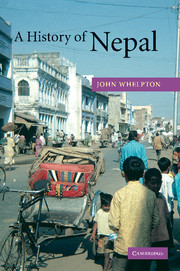Book contents
- Frontmatter
- Contents
- List of illustrations
- List of maps
- List of tables
- Key events
- Acknowledgements
- Notes on romanisation and terminology
- List of abbreviations
- Introduction
- 1 Environment, state and society in the central Himalayas to 1743
- 2 Unification and sanskritisation, 1743 – 1885
- 3 Nepal under the Shamsher Ranas, 1885 – 1951
- 4 The monarchy in ascendance: domestic politics and foreign relations, 1951 – 1991
- 5 The quest for ‘development’: economy and environment, 1951 – 1991
- 6 Lifestyles, values, identities: changes in Nepalese society, 1951 – 1991
- 7 Democracy and disillusionment: Nepal since 1991
- Genealogical tables
- Biographical notes
- Notes
- Glossary
- Bibliography
- Index
7 - Democracy and disillusionment: Nepal since 1991
Published online by Cambridge University Press: 05 June 2016
- Frontmatter
- Contents
- List of illustrations
- List of maps
- List of tables
- Key events
- Acknowledgements
- Notes on romanisation and terminology
- List of abbreviations
- Introduction
- 1 Environment, state and society in the central Himalayas to 1743
- 2 Unification and sanskritisation, 1743 – 1885
- 3 Nepal under the Shamsher Ranas, 1885 – 1951
- 4 The monarchy in ascendance: domestic politics and foreign relations, 1951 – 1991
- 5 The quest for ‘development’: economy and environment, 1951 – 1991
- 6 Lifestyles, values, identities: changes in Nepalese society, 1951 – 1991
- 7 Democracy and disillusionment: Nepal since 1991
- Genealogical tables
- Biographical notes
- Notes
- Glossary
- Bibliography
- Index
Summary
PARTIES AND POLICIES, 1991–1999
The Congress administration under Girija Prasad Koirala which succeeded the coalition government in May 1991 faced vigorous opposition from the Communist Party of Nepal (UML) and the smaller Communist parties, including the repetition on a smaller scale of the street protests that had been used against the old Panchayat administration. Controversy arose almost immediately when civil servants began a third round of agitation. Koirala took an extremely firm line and a number of government employees linked to the UML, which had sympathised with the action, lost their jobs. This was to become a running sore in relations between Congress and the main opposition party, since members among lower-ranking public employees had long been an important part of the UML's support base. The issue was soon, however, eclipsed by two others. Despite its own earlier socialist orientation, Congress adopted the neo-liberal economic policies favoured by the aid donors and the resulting price rises stoked discontent. In addition, Koirala was felt by many to have secured an insufficient share of electric power and water for Nepal in an agreement legalising India's construction of a dam on Nepalese territory at Tanakpur on the Mahakali River. Street demonstrations against these policies, in which the UPF and Masal took the lead, turned violent on 6 April 1992, the second anniversary of the Darbar Marg shootings during the janandolan. At least twelve people died in police firing, partly because both training and equipment were inadequate, but also possibly because individual policemen wanted revenge for the killing of some of their colleagues the previous year. The extreme left groups responded with a campaign calling for the government's resignation. The UPF had only limited support in the Valley, as was shown by its candidate in the Kathmandu mayoral election in May winning only 3.4 per cent of the vote, but the one-day strike they called the same month kept almost all traffic off the roads. As on numerous subsequent occasions, fear of attack by demonstrators throwing stones or worse was enough to enforce compliance.
The UML needed to preserve its own credibility as the main force on the left but also to maintain the image of a responsible opposition.
- Type
- Chapter
- Information
- A History of Nepal , pp. 189 - 235Publisher: Cambridge University PressPrint publication year: 2005



